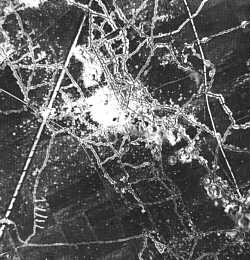

Trench Warfare: Warfare in which opposing armed forces attack, counterattack, and defend from relatively permanent systems of trenches dug into the ground. The opposing systems of trenches are usually close to one another. Trench warfare is resorted to when superior firepower of the defense compels the opposing forces to "dig in" so extensively as to sacrifice their mobility in order to gain protection. A trench system basically starts with a series of foxholes dug quickly by troops using a number of random tools. In length, the foxholes tend to be able to shelter a soldier safely that is standing upright. When a number of foxholes are built they are all connected by shallow crawl trenches. This is how a trench system is started. From here, a more permenant system can be constructed. The soil excavated from the trenches is used to build raised parapets on both sides of the trench. Inside the trench there is a raised step called a fire step, and it is used for firing positions by the troops. To provide sturdy footing duckboards were inserted into the bottom of the trench.
Trench warfare was first established by the French military engineer Sebastien Le Prestre de Vauben. The trenches were used for the attack of fortresses in the 17th century. Trench warfare remained only a part of siegecraft until the opposing firepower compelled both sides to use trenches in the American Civil War. The foremost example of trench warfare in the American Civil War was the lines of the Petersburg, Virginia theater in the closing months of the war. Trench warfare reached it's highest point in World War I, and more specifically, in the Western Front. The tenches contained millions of troops facing each other from the Belgian Coast, through northeastern France, and all the way to Switzerland. The trenches were built in the first few months of the war after Germany and France had led offensives only to be destroyed by the onslaught of rapid-fire artillary pieces, and especially the, new-and-improved machine gun.
Trench Systems in WWI
The average trench system in World War I had a series of 2 to 4 or more trench lines running parallel to one another and being at least one mile in depth. The trenches were built in a zig-zag formation. The reasoning behind this was so that no enemy troops standing at one end of the trench could shoot more than a few yards down. The main lines were all connected to each other and to the rear by a bunch of communications trenches. These were dug perpendicular to the main trenches. By way of the communications trenches came food, mail, ammunition, more troops, and new orders. The network of trenches also consisted of command posts, forward supply dumps, first-aid stations, kitchens, and latrines. Also, most importantly, it had machine gun emplacements for defending attacks, and it had a large number of dugouts to shelter troops against bombardments. The front line was known as the outpost line, and it was held by machine gunners behind barbed wire. The main resistance was behind them in the 2nd, 3rd, and 4th lines where the main supply of troops was. The main artillary was by the rear of the main trenches. The Germans develped pillboxes, concrete dugouts for machine guns. By 1918, the germans had developed trenches that spanned for about 14 miles.
The Antidote for Trench Warfare
One simple word can sum up how the Allies nutralized trench warfare. TANKS. The Allies began using a larger number of tanks to cross "no-mans-land", the area between two opposing trench systems. Becuase tanks are impervious to machine guns they had no fear when they crossed the battle plain.
Trench warfare was a crucial element when it came to World War I. It protected troops from enemy fire, and it prevented many men from falling to the machine gun. Without trench warfare the casualty list would have been a lot higher than 8 million soldiers.
Images of Troops in Trenches
Back to Home